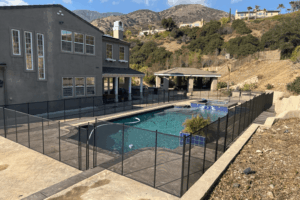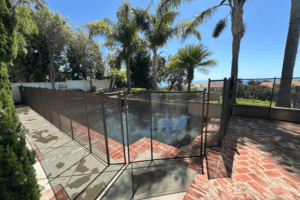
10 Questions to Ask Before Buying a Pool Safety Fence
Don’t buy a pool safety fence without asking these essential questions. This buyer’s guide helps you evaluate height, compliance, materials, installation, and more.

To get the most out of your backyard pool, knowing the difference between swimming pool facts and myths is important. More than that, it’s your responsibility as a safe pool owner to understand the truth behind common misconceptions. This helps you create a safer swimming pool environment for your family, friends, pets, and guests while still enjoying your backyard oasis.
This is one of the most common swimming pool “facts” that just doesn’t hold water. Owning a swimming pool comes with the responsibility of maintaining that swimming pool, which takes both time and money. For some people, the temptation of skipping the expense or effort becomes too great, and they fall victim to this myth. While clear water may very well turn out to be clean, it could also harbor microscopic bacteria and contaminants, and even technically clean water may not be of a condition you should swim in.
Your pool uses a delicate balance of chemicals to keep the water clean, avoid stagnation, and inhibit the growth of microorganisms while still being within a range of chemical saturation that won’t hurt you or other swimmers. Check your water regularly, make adjustments as needed, and do your research to understand what it takes to create and maintain healthy and safe pool water.
This myth prevails because as far as municipalities are concerned, your property’s fence may satisfy the legal requirements of owning a pool, but that isn’t always the case. Furthermore, in many cases, while it may satisfy your legal liability requirements, it doesn’t actually offer the protection you need. Swimming pool safety barriers do more than protect you from potential lawsuits, they protect the lives of anyone on your property, including adults, children, and pets.
One of the most tragic swimming pool facts is that an average of ten people die daily from accidental drowning in a swimming pool. Drowning is also the top cause of accidental death for children under four years of age, and for every life-ending tragedy, scores more children need emergency medical intervention following a near-drowning incident. Swimming pool safety barriers, such as fences, safety covers, and nets, provide a physical last line of defense between the water and someone who may not be able to make it to safety if they fall in.
We’ve all heard not to go into the water an hour after eating–or is it 30 minutes–an hour? How much food does it take to trigger this danger? Does it have to be a meal, or does the birthday cake your child ate count? Relax. Swimming after eating doesn’t necessarily create a dangerous situation.
This myth was based on the erroneous thought that swimming reduced the amount of blood necessary for proper digestion and that without proper digestion, you could get cramps that racked your body with so much pain you could drown. While strenuous activity of any kind right after a big meal might lead to some unpleasant feelings, this has more to do with over-consumption than with any water activities. Use good judgment, and you can enjoy a sensible meal and get your laps in.
Many swimmers have already debunked this myth to their painful chagrin, while others still swear this belongs on a list of swimming pool facts. Proponents point to long hours at the beach and using their backyard pools. Detractors point to the sticky smell of their favorite aloe gel. So who’s right? The short answer is you just can’t count on the water protecting you.
Water does absorb the UV-B radiation responsible for causing a sunburn, but it would take several meters of reliable protection to eliminate that radiation entirely. A half-meter of water will offer around 40% protection, but as we swim, we don’t stay at exactly a half meter of water, and even if we did, that still lets 60% of the radiation through. Whether or not this would be enough to cause a burn depends on the time you’re exposed, the actual amount of absorption over that time, and your body’s own makeup that affects your likelihood of developing a sunburn. As with swimming pool safety fences, you’re better safe than sorry. Use sunscreen and reduce your exposure to help avoid sunburns and a greater risk of melanoma.
One of the most dangerous swimming pool facts around, this misconception has led to tragedy for many families. Children should never have unsupervised access to a swimming pool, even if they are strong swimmers. While they may have had swimming lessons from the time they were in diapers, the risk of something going wrong is too great, especially if more than one child might be involved.
Children make mistakes, and an ill-advised decision might be made if the potential for fun outweighs their sense of caution. Even with good decision-making skills and self-control, young bodies are still developing. This can lead to situations, such as cramps or pains, they don’t have the strength or body control to “swim through” and reach safety. In addition, they may not be prepared should an emergency take place, whether that’s a water incident with a friend, an electrical hazard, or equipment malfunction. Keep your swimming pool safety fence secure and the kids out when an adult isn’t around.
A swimming pool barrier system keeps your backyard pool ready for action and your family, friends, and pets safer, and that’s one of the swimming pool facts you can take action on today. Designed to prevent accidental entry into the water, safety fences, safety covers, and safety nets are sturdy, cost-effective ways to get added peace of mind. Contact us to schedule a visit from a local installer ready to design a pool safety solution for your property today.

Don’t buy a pool safety fence without asking these essential questions. This buyer’s guide helps you evaluate height, compliance, materials, installation, and more.

Understand how local pool fence codes work and what to check before installation. This beginner’s guide simplifies requirements so your safety barrier complies and protects effectively.

Learn the truth behind common pool safety myths and make better decisions to protect your family with fact‑based guidance on fences, barriers, and maintenance.
Enter your zip code to locate an independent installer in your area
Enter your zip code to locate an independent installer in your area

Due to the many variations in monitors, phones, and browsers, color samples and product examples may appear different on different screens. Computers and mobile devices are not all calibrated equally and color reproduction on the Internet is not precise. The same is true for printed items such as brochures and other sales literature.
In addition, the colors of our products photograph differently under different lighting conditions. For example, photos taken in full sunlight will vary from photos taken on a cloudy or overcast day. Similarly, shadows from nearby objects can affect the color and transparency of our products. If a precise color or specific shade is important, please inspect the actual color of your product prior to installation.
Many of our products’ materials are not available through typical stores and vendors and therefore must be custom manufactured specifically for our use. In order to control costs and provide you with the best value possible, our raw materials are produced in large batches and can often take several months to receive. The colors of our materials can, and often do, vary slightly from batch to batch. Although we make every effort to minimize color variations, we cannot be responsible for these differences when they occur. If a precise color or specific shade is important, please inspect the actual color of your product prior to installation.
For example, we use the name “putty” to describe some of our products. Your idea of the color “putty” may be different than someone else’s idea of “putty”. In addition, products may have the same color name but may not be the exact same color. For example, we have different shades of “black”. Please do not order using color names as your only guide. If a precise color or specific shade is important, please inspect the actual color of your product prior to installation.
If it is important that your product be an exact color or shade, it is highly recommended that you inspect the actual product prior to its installation and address any concerns with your local independent installer. Most independent installers do not offer refunds or accept returns due to color variations.